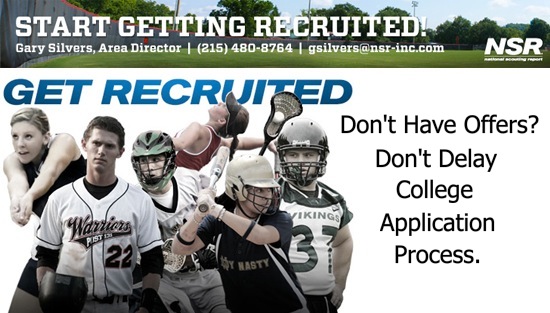- Log in to post comments
The following article is sponsored by National Scouting Report. Visit NSR’s web site at http://www.nsr-inc.com/

DON’T HAVE OFFERS? DON’T DELAY COLLEGE APPLICATION PROCESS
By Gary Silvers
The NCAA early signing period is just a week away. The regular signing period is just a few months after that.
The early decision application period has begun. The regular decision application period is quickly approaching. You have application deadlines to meet.
You want to play college sports. You are on the recruiting radar. But you have yet to receive any offers.
What should you do?
Should you start applying to colleges? Should you contact the coaches? Should you hold out for offers?
Answer: all of the above.
“You have to cover all of your bases for admission,” said Alan Parham, NCAA compliance officer for National Scouting Report, the world’s oldest and largest high school scouting and college recruiting organization. “The earlier prospects can apply to and be accepted by colleges, the better off they are.”
High school guidance counselors recommend applying to at least five schools because many student-athletes ultimately decide where to attend college based upon the financial aid packages they receive.
If a prospect has been vigorously recruited, college coaches encourage them to apply. Application fees -- the average is $37.88 -- can add up quickly, but many coaches offer an athletic waiver to cover the cost.
Once a prospect applies, he or she should contact the college coach immediately. The coach needs to know how much academic money the student-athlete qualifies for, so the coach can decide how much athletic money to add to the package.
If a student-athlete has no offers, Parham said, he must take a proactive approach. He should apply to the schools he’s really interested -- academically and athletically -- and receive an initial financial aid package.
“If a prospect has a high GPA, test scores and class rank and receives a significant amount of academic money, that could sway a coach to make an offer,” Parham said. “It doesn’t put as big a strain on the coach’s athletic budget to make school affordable. That gives prospects a competitive advantage over others with similar athletic skills.”
If a prospect doesn’t apply to a school before the application deadline, he or she still can receive an offer from a college coach and, ultimately, sign a National Letter of Intent (NLI) with that school. NCAA Division I and II schools hold spots in school for student-athletes.
“It’s rare when a coach hasn’t made an offer before the start of the regular signing period in February (football, soccer and men’s water polo) or April (all other sport),” Parham said. “However, prospects can be admitted to a school all the way up to the start of the next school year if they haven’t signed an NLI with another school.”
The most important thing, Parham said, is for prospects to stay in touch with college coaches as long as possible. You never know when another student-athlete may back out, opening the door for somebody else.
“You must continue working the [recruiting] process,” Parham said. “That way a coach knows you are still interested. You may be the first one he turns to.”
High school athletes who have not received verbal offers from college coaches should contact National Scouting Report, the world’s oldest and largest high school scouting and college recruiting organization.NSR has received hundreds of requests from college coaches seeking qualified prospects (2016-19). More than 95 percent of NSR’s prospects receive scholarship offers. For a FREE in-home consultation, contact Area Director Gary Silvers at (215) 480-8764 or gsilvers@nsr-inc.com.

